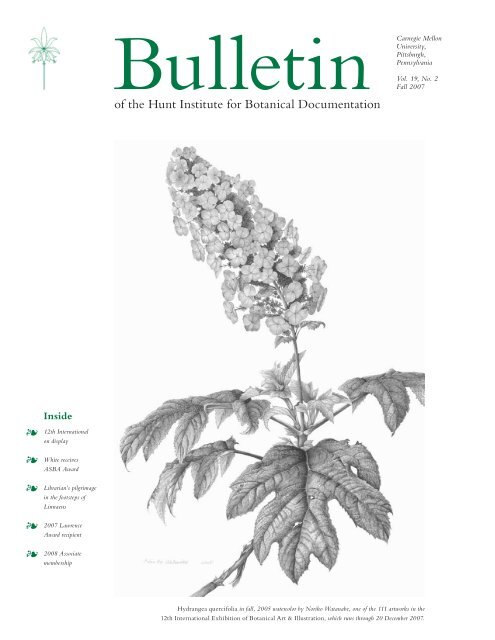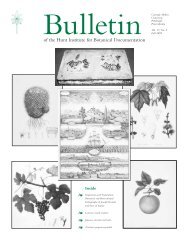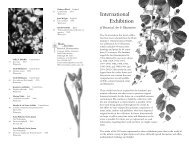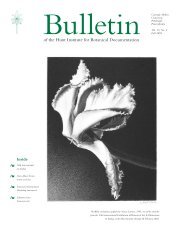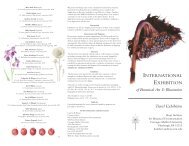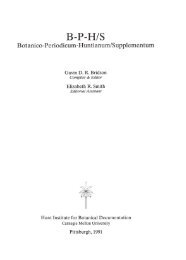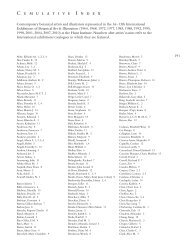Volume 19, No. 2. 2007. - Hunt Institute for Botanical Documentation
Volume 19, No. 2. 2007. - Hunt Institute for Botanical Documentation
Volume 19, No. 2. 2007. - Hunt Institute for Botanical Documentation
You also want an ePaper? Increase the reach of your titles
YUMPU automatically turns print PDFs into web optimized ePapers that Google loves.
Bulletinof the <strong>Hunt</strong> <strong>Institute</strong> <strong>for</strong> <strong>Botanical</strong> <strong>Documentation</strong>Carnegie MellonUniversity,Pittsburgh,PennsylvaniaVol. <strong>19</strong>, <strong>No</strong>. 2Fall 20074444Inside12th Internationalon displayWhite receivesASBA AwardLibrarian’s pilgrimagein the footsteps ofLinnaeus2007 LawrenceAward recipient42008 AssociatemembershipHydrangea quercifolia in fall, 2005 watercolor by <strong>No</strong>riko Watanabe, one of the 111 artworks in the12th International Exhibition of <strong>Botanical</strong> Art & Illustration, which runs through 20 December <strong>2007.</strong>
Current and upcoming exhibits12th International opensThe 12th International Exhibition of <strong>Botanical</strong> Art & Illustrationpreviewed on Thursday, 27 September <strong>2007.</strong> The gallerywas filled to capacity with some of the finest contemporarybotanical art being produced today. We were so pleased that29 of the 64 artists represented in our exhibition and over 180American Society of <strong>Botanical</strong> Artists (ASBA) members intown <strong>for</strong> their annual conference at the Holiday Inn Select,Oakland, attended the reception. Our Associates may havebeen surprised to see our gallery so crowded <strong>for</strong> those two shorthours, but I hope they enjoyed the convivial and celebratoryatmosphere. It was such a pleasure to see botanical artists fromaround the world interacting and reconnecting while viewingour exhibition, and it felt like a large family reunion. Manyartists remarked that this was our best International to date.Images from the reception are available at . A full-color, illustrated catalogue of the 12thInternational is available <strong>for</strong> sale (see p. 12).On the day following the reception James White and Iattended an ASBA portfolio review in search of new talent<strong>for</strong> our 13th International in 2010. That event was followedby the ASBA sponsored luncheon and many workshops.Saturday, the <strong>Hunt</strong> <strong>Institute</strong> participated in the conferencewith a morning lecture by Curator of Art James White,Archivist Angela Todd and Librarian Charlotte Tancinon “The History of the <strong>Hunt</strong> <strong>Institute</strong>” (with a display ofrare books, artworks and archival materials from all threedepartments). In the afternoon Curator of Art James Whiteand I gave presentations on Anne Ophelia Todd Dowden.We displayed a sampling of several of her original artworksand other archival materials from our collection of over 450original watercolors and preparatory sketches, as well as avast holding of correspondence, manuscripts, photo portraitsand other ephemera documenting the career of this recentlydeceased botanical artist (a bequest to the <strong>Institute</strong> in 2007).It always is a pleasure to share this collection with botanicalartists, many of whom are inspired by her paintings as well asher life as an artist. At the closing ASBA banquet on Saturdayevening, Curator of Art James White was the well-deservingrecipient of the ASBA Award <strong>for</strong> Service to <strong>Botanical</strong> Art(see p. 4). It was a joy to see him honored with a standingovation. The three days of activities were exhilarating andexhausting, but our staff enjoyed interacting with so manyartists and sharing our special collections, which can also beused by artists as a tool <strong>for</strong> learning more about botanicalart history, technique, style and composition. It is excitingto see the interest in the genre of botanical art growing inthe United States, reflected by the growing membership ofASBA in just 13 years.Over the weekend we were <strong>for</strong>tunate to be given threeartworks by 12th International artists: Josephine EystonElwes’s 2004 watercolor Iris foetidissima; Alison Gianangeli’s2006 watercolor Tulipa, Hybrid cultivar, Parrot, ‘Rococo’;2Bull. <strong>Hunt</strong> Inst. Bot. Doc. <strong>19</strong>(2), Fall 200712th International artists (from left) Dick Rauh, Carol Weld andDeirdre Bean with Curator of Art James White (third from left).Photo by Frank A. Reynolds.and Julia Trickey’s 2006 watercolor Rumex obtusifolius leaf.Wendy Brockman (8th International) gave us her 2007watercolor on vellum Quercus rubra because she wantedus to have one of her more recent artworks. Other 12thInternational artists also promised gifts of their artworks inthe future. We are most grateful to the 12th Internationalartists who donated works from the exhibit: FusakoAbe’s 2005 watercolors Hemerocallis vesperitina and Lilium<strong>for</strong>mosanum; milly acharya’s 2006 watercolor Cleome; DeirdreBean’s 2006 watercolor Aechmea, ‘Pink Rocket; MargaretBest’s 2006 watercolor Mespilus germanica; Elisabeth de Boor’s2003 pencil drawing Fragaria virginiana, Wild Strawberry;Carolyn Cappello’s 2004 watercolor Hemerocallis, Bronzedaylilies; Kang Chung’s 2006 colored pencil drawingsApricots and Peppers; Sarah Gould’s 2002 watercolorsMango and Tamarillo; <strong>No</strong>rma Gregory’s 2006 watercolorand colored pencil Bergenia and 2006 watercolor and graphiteAesculus hippocastanum; Carol Hartley’s 2004 watercolorProtea cynaroides; Mayumi Hashi’s 2004 and 2005 watercolorsEncyclia cochleata and Encyclia dickinsoniana; Celia Hegedüs’s2002 and 2005 watercolors Fritillaria meleagris and ‘Talisman’[Tulipa]; Doreen Jones’s 2005 watercolors Viburnum opulus‘Fructu-Luteo’ and Viburnum tinus ‘Pink Prelude’; LaurettaJones’s 2003 watercolor Sage and Leaf, Salvia officinalis;Yoshiko Kamei’s <strong>19</strong>98 and <strong>19</strong>99 watercolors Anemone andHydrangea; Ruriko Kato’s 2003 watercolor Banksia; LibbyKyer’s 2003 watercolor Cucurbita foetidissima ‘Buffalo Gourd’;Hiroko Mima’s 2002 and 2006 watercolors Ardisia crenataand Heracleum dulce; Naomi Morino’s 2003 watercolorMushrooms; Mariko Nishimoto’s 2004 watercolorAmaranthus tricolor; Dick Rauh’s 2006 watercolors Stewartiarostrata and Leonurus cardiaca; Silvana Rava’s 2006 watercolorAllium carinatum; Margaret Saul’s 2003 watercolor YellowMangosteen (Atractocarpus fitzalanii); Elaine Searle’s 2004watercolor and graphite Astrophytum myriostigma var. nudum;Shirley Slocock’s 2006 watercolor Bignonia grandiflora; HalinaSteele’s 2004 and 2006 watercolors Hibiscus meraukensis andCotton Harlequin Bug (Tectocoris diophthalmus) and Alyogynehuegelii (Lilac Hibiscus) and Rayed Blue Butterfly (Candalidesheathi heathi); Eva Stockhaus’s <strong>19</strong>86 wood engraving August/Silene and Cichorum; Peta Stockton’s 2006 watercolor Protea(continued on p. 4)
cynaroides whorl; Dianne Sutherland’s 2002 watercolorGloxinia; Sandy Ross Sykes’ 2004 watercolor Hedychiumgreenei; Harue Takumi’s 2006 watercolor Japanese quince,Chaenomeles speciosa; Eriko Miki Tosaki’s 2006 watercolorsCommelina communis L. and Carthamus tinctorius L.; <strong>No</strong>rikoWatanabe’s 2005 watercolors Hydrangea quercifolia in fall andHydrangea quercifolia in late fall; Carol Weld’s 2006 watercolorGloriosa superba; Heidi Willis’s 2003 and 2005 watercolorsChorisia speciosa and Eucalyptus capsules; and Etsuko Yamane’s2006 watercolor Polygonatum odoratum var. pluriflorum cv. Theartworks from this exhibition that are in our collection willbe organized into a travel exhibition circulated to museums,galleries and botanic gardens throughout the continentalUnited States and will be available in February 2008.Spring 2008 exhibitionIn March we will display a selection of botanical watercolors bythe English naturalist, author and artist Edward O. Donovan(1768–1837) from our collection of 662 paintings createdbetween 1823 and 1830. He is best known <strong>for</strong> the naturalhistory publications he authored and illustrated, includingthose on British insects, shells, fish and quadrupeds and theinsects of China, India and New Holland. Donovan, a manof means, was among those avidly collecting exotic naturalhistory items brought back from voyages of exploration. Itbecame the rage <strong>for</strong> gentlemen to create cabinets of curiosities,and some, including Donovan, opened small public museums.His London Museum and <strong>Institute</strong> of Natural History,opened in 1807, included several hundred cases of birds,botanical specimens and other objects. By 1818 his collectionswere auctioned due to financial difficulties precipitated by hisdealings with unscrupulous publishers. There is record of his1833 plea to the public <strong>for</strong> funds to contest these matters inthe courts be<strong>for</strong>e the statute of limitations, but it was to noavail since he died penuriously. We are currently selectingpaintings to display and searching <strong>for</strong> more clues about the1823–1830 period of our collection.— Lugene B. Bruno, Assistant Curator of ArtAbove: Trevor Haddrell’s 2005 linocut Five Courgette Flowers.ASBA Annual Award <strong>for</strong> Service to <strong>Botanical</strong> ArtAt the banquet on Saturday, 29 September 2007, theAmerican Society of <strong>Botanical</strong> Artists presented its Award<strong>for</strong> Excellence in the Service of <strong>Botanical</strong> Art to Curatorof Art James J. White in recognition of his outstandingwork in support of botanical art. Jim is a founding memberof ASBA, which held its first annual meeting at the <strong>Hunt</strong><strong>Institute</strong> on 8–9 <strong>No</strong>vember <strong>19</strong>95. The ASBA continuesto meet in Pittsburgh at the time of each InternationalExhibition (triennial). The ASBA’s second chapter, thelocal Allegheny Highlands <strong>Botanical</strong> Art Society, visitsthe <strong>Institute</strong> each December <strong>for</strong> a curator’s choice displayof items from our collection and has voted this event theirfavorite of the year.Within ASBA the three-person Awards Committee,comprised of Chair Mary Bauschelt (9th International),Martha Kemp (9th International) and Catherine Watters,conducted the selection process with the highest levelof secrecy. Martha extended the aura of mystery to herintroduction — “The person we honor this year with theASBA’s Service to <strong>Botanical</strong> Art Award belongs to andserves, or has served, as an officer in so many national andinternational organizations relating to botanical art that itwould take until dessert to read the entire list. Leaving theSmithsonian in <strong>19</strong>78 <strong>for</strong> his — or her — current position,traveling five times to India to document botanical artworks,spending a year there as a Fulbright research scholar, recentlydeveloping an international register of botanical art <strong>for</strong>the Web, and working in countless other related ways tocontribute to the world of botanical art, we know her — orhim — as a generous and tireless supporter of the ASBAfrom the very beginning. For the fourth time since thefounding of the ASBA, our annual meeting has been heldin this person’s city. Two nights ago we all enjoyed beingguests at his institution’s 12th International exhibition. It is aprivilege to announce that James J. White is the recipient ofthe 2007 Award <strong>for</strong> Service to <strong>Botanical</strong> Art.” Thus Jim wascompletely surprised when Martha announced his name andremains deeply honored to have received the Award.4Bull. <strong>Hunt</strong> Inst. Bot. Doc. <strong>19</strong>(2), Fall 2007
Anne Ophelia Todd Dowden Art Acquisition FundThe <strong>Hunt</strong> <strong>Institute</strong> <strong>for</strong> <strong>Botanical</strong> <strong>Documentation</strong> is pleasedto name its art acquisition fund in honor of the late artistAnne Ophelia Todd Dowden (<strong>19</strong>07–2007). A <strong>19</strong>30 graduateof Carnegie <strong>Institute</strong> of Technology (now Carnegie MellonUniversity), Anne Ophelia is considered America’s leadingbotanical artist of the past century. After working as a teacherand a textile designer, Anne Ophelia turned her attentionto botanical illustration in the <strong>19</strong>50s, embarking on anothercareer. She worked from specimens to achieve correct andexacting details in her artworks and with botanists to ensureaccuracy. Fascinated by the natural world and its connections,especially pollination, she wanted to educate, interest andengage the public about plants. To this end, she illustratednine books and wrote and illustrated eleven <strong>for</strong> which shealso did the design, layout and publication preparation herselfdecades be<strong>for</strong>e desktop publishing. Her passion <strong>for</strong> botanicalart, science and education made her so special and inspired ageneration of artists. She also maintained numerous contactswith botanists, artists and botanical gardens, and whenevershe spotted new artistic talent, she made recommendationsto the <strong>Hunt</strong> <strong>Institute</strong>.The naming of this acquisition fund after Anne Ophelia is afitting tribute to her legacy. Our restricted budget hampersthe acquisition of works by artists, particularly those newto our series of International Exhibitions. Unlike funds inour regular budget, which are contingent on the fiscal year,monies in the Anne Ophelia Todd Dowden Art AcquisitionFund will remain available until needed. The purchaseof artworks from this fund will enable us to support andrecognize artists working in the genre of botanical art.Our collection includes Anne Ophelia’s bequest of over 450artworks from which we have organized several exhibitionsand travel shows. In donating her artworks to the <strong>Institute</strong>,Anne Ophelia wanted them to be preserved, but she alsowanted them to be accessible <strong>for</strong> study by botanical artists.This fund will allow us to preserve artworks by the currentgeneration of botanical artists and make them available <strong>for</strong>study by the next.Individuals, as well as botanical art societies and otherorganizations, may find this fund an attractive way to supportthe <strong>Hunt</strong> <strong>Institute</strong>. We are very pleased to thank Lotte H.Blaustein and the American Society of <strong>Botanical</strong> Artists <strong>for</strong>the first donations to this fund. For further in<strong>for</strong>mation,contact Curator of Art James J. White (412-268-2440;jw3u@andrew.cmu.edu).Open House 2007Building on the Associates Week held in June 2006, wedecided to expand the event into an Open House andextend an invitation to everyone. The 2007 event was heldon 3 and 4 June. In attendance were our Associates, thoseon our exhibition mailing list, members of the WesternPennsylvania Unit of the Herb Society of America, colleaguesfrom Carnegie Mellon and a number of newcomers. We hadapproximately 90 visitors during the two-day event.On Sunday we offered tours of the herb exhibition and thereading room, tours of our Library and Art department withdescriptions of the collections and activities by the curators,and brief overviews of our Bibliography department andArchives by the curators. Archivist Angela Todd gave a talktitled “Agnes Arber: Quiet and Independent Herbarist,”and Librarian Charlotte Tancin followed with “Herbals asScientific Communication in 15th–17th Century Europe.”On Monday we extended the program to include tours ofour third-floor offices, including Archives, Bibliography andGraphic Services.We greatly appreciated the enthusiasm of the attendees andthank everyone <strong>for</strong> participating. The event is certainlygaining momentum. We will continue to fine-tune theprogram (we promise to schedule breaks next time!) andhope to plan an exciting event <strong>for</strong> next year.— Scarlett T. Townsend, Editor(continued from p. 6)color portraits of Linnaeus (1707–1778) in Laplander dresswas featured in the June 2007 issue of National GeographicMagazine, accompanying “A Passion For Order: CarlLinnaeus” by David Quammen. Linnaeus in his red weddingcoat appeared in Frank Egerton’s “A History of EcologicalSciences, part 23: Linnaeus and the Economy of Nature”in the January issue of the Bulletin of the Ecological Society ofAmerica. Wayne Elisens, professor of botany and curator of theBebb Herbarium at the University of Oklahoma, has hungour portrait of taxonomist Michael Bebb (1833–1895) in theherbarium. The Robert Bebb Herbarium was named afterMichael Bebb’s son, who donated his herbarium of 30,000specimens to the University of Oklahoma. Diana Davis’book Resurrecting the Granary of Rome: Environmental Historyand French Colonial Expansion in <strong>No</strong>rth Africa (Athens, Ohio,2007) used our portraits of paleobotanist Louis Emberger(1897–<strong>19</strong>69) and phytogeographer Charles Flahault (1852–<strong>19</strong>35). VIMAgazino, a newspaper supplement in Athens,Greece, used three of our portraits of explorer Joseph Rock(1884–<strong>19</strong>62) in October. Random House included a portraitof Linnaeus in their Encyclopedia of Dinosaurs by Thomas R.Holtz, Jr. (New York, 2007). The Tennessee Conservationistmagazine used our portrait of ecologist Henry Knute Svenson(1897–<strong>19</strong>86) in their September/October issue.— Angela L. Todd, ArchivistBull. <strong>Hunt</strong> Inst. Bot. Doc. <strong>19</strong>(2), Fall 2007 7
<strong>No</strong>tes from the FieldA Trip to UppsalaThe life and legacy of Carolus Linnaeus (1707–1778) are beingcelebrated all over the world in this tercentenary year of hisbirth. The natural center of the celebration has been Uppsala,Sweden, where Linnaeus spent his professional life, and theapex of the activity was on 23 May, his birthday. However,celebrations have also been taking place in many countries,ranging from symposia and exhibitions to displays of hisportrait with bouquets of flowers. Although I was unableto be at the epicenter <strong>for</strong> this celebration in May, I did visitin September. With the aid of a grant, I attended the 12thmeeting of the Linnaeus Link project, which was held inUppsala. This was my second trip to Sweden, the first beingdescribed in the 13(2) Bulletin (2001, pp. 8–9, 11), and duringmy brief stay I revisited several key Linnaean sites.Following our first full day of meeting sessions, we touredthe Linnémuseet (below) — the museum now located in thehouse where Linnaeus and his family lived in Uppsala — withcurator Eva Björn, who guided us through the recentlyrenovated interior and shared anecdotes connected with thevarious displays. The renovations, done <strong>for</strong> the tercentenary,were aimed at restoring to the museum the feel of a home, animpression that has been strengthened by the reintroductionof period wallpapers. Eva talked about the earliest, repeatedef<strong>for</strong>ts to grow tea in Sweden; Linnaeus’s acquiring of theLinnaea borealis china dinnerware; how an art conservatorworking on the original painting of Cupid, Flora, Ceresand Asculapius honoring the bust of Linnaeus removed theentire top layer of overpainting to find a better version of thepainting underneath; and how the revolutionary design ofthe tall, tiled stoves found in mid-18th-century homes wasso effective that it changed the quality of life in Sweden.From the museum we walked into the garden to admirethe beds of plants in the early twilight be<strong>for</strong>e dinner.There were many fall flowers blooming, and the centralpath was bordered by tall sunflowers. Our meeting host,Viveca Halldin <strong>No</strong>rberg, had arranged a buffet dinner inthe orangerie situated at the head of the garden and had8Bull. <strong>Hunt</strong> Inst. Bot. Doc. <strong>19</strong>(2), Fall 2007Page 8, bottom: The Linnaeus Museum and <strong>Botanical</strong> Gardenin Uppsala; top: Hammarby, country home of Linnaeus; page9, top: Looking toward Linnaeus’s bedroom from his study;middle: The words painted on the bedroom door frame; bottom:Linnaeus’s tomb at the Uppsala Cathedral; inset is another viewof the tombstone. Photos by Charlotte Tancin.invited a number of people from the university and elsewherein the area who have been involved in the tercentenarycelebrations and in promoting the Linnaean legacy. Theresult was a lovely social evening replete with good food,good wine and good company. Many toasts were offered inthe unadorned, candlelit interior of the orangerie where, inthe past, susceptible trees such as citruses were moved indoors<strong>for</strong> protection during the winter months.After the end of our second day of discussions, we visitedHammarby (above), Linnaeus’s country home, <strong>for</strong> a guidedtour of the house and grounds. The home retains some ofthe furnishings from his time there, including numerousfamily portraits and the wedding portraits of Linnaeus andhis wife. The photo shown here (p. 9, top) is a view from hisstudy looking toward the bedroom. The doorway is flankedby six portraits and eight high-backed chairs. The study wallsare papered with uncolored botanical plates from the workof Charles Plumier (1646–1704), and the bedroom wallsare covered with hand-colored engraved plates by GeorgDionysius Ehret (1708–1770). Above the bedroom dooris a drawing of a pair of whales, surmounted by a carvedbird, and on the door frame beneath are painted the words,“Innocue vivito: Numen adest” [Live innocently: God ishere] (p. 9, middle). Outdoors we walked the grounds and sawthe small building that Linnaeus had constructed to house hisspecimens. Our guide talked to us about the plantings thatwould likely have been there in Linnaeus’s time and showedus several walking paths that have persisted in the woodedlandscape behind the house and outbuildings.Linnaeus is buried beneath the Uppsala Cathedral. <strong>No</strong>rmallyhis tombstone, like the others, is set flush with the stonefloor of the cathedral and identifiable only upon close view.However, in honor of the tercentenary, Linnaeus’s tombstoneis ringed by a living frame of plants and highlighted with aspotlight. This photo (p. 9, bottom) shows the tomb as it islocated in the back area of the cathedral, and the inset givesa view of the text on the tombstone.
Although I thoroughly enjoyed this pilgrimage in thefootsteps of Linnaeus, the primary purpose of my trip wasto represent <strong>Hunt</strong> <strong>Institute</strong> at the Linnaeus Link meeting.The meeting was arranged and chaired by Viveca Halldin<strong>No</strong>rberg, senior specialist at the Cultural Heritage Group,Uppsala University Library, and the sessions were conductedmostly at the Carolina Rediviva library on 20–21 September<strong>2007.</strong> On Thursday morning we were welcomed by ChiefLibrarian Ulf Göranson, and <strong>for</strong> the next two days wediscussed project accomplishments, work currently inprogress, next steps, new ideas and goals <strong>for</strong> the future.Linnaeus Link has largely been managed and administeredat the Natural History Museum in London and was mostrecently headed by Diane Tough. <strong>No</strong>w managementand administration are passing to the Linnean Society ofLondon, which funds the work of the project, and the projectleader will be Lynda Brooks of the Linnean Society. Ouraccomplishments thus far include a large-scale cataloguingproject of Linnaean material at NHM; the design, testingand early implementation of a union catalogue; an ongoingsurvey of Linnaean collections worldwide; some digitization;and a Web site describing the project and making some ofits results available online.At the beginning of this year’s meeting, the group comparednotes on cataloguing Linnaean material in our respectivelibraries. Among these reports was that of the Natural HistoryMuseum, where project cataloguers have produced 1,573catalogue records <strong>for</strong> Linnaeus Link. While the bulk of theproject cataloguing was done at NHM, the rest of us reportedon our ef<strong>for</strong>ts. Barbara Hawes announced the publication ofthe Catalogue of Scandinavian Books in the British Library PrintedBe<strong>for</strong>e 1801. Catalogue records in participating institutions arebeing coded in a way that will enable them to be harvestedin the Linnaeus Link union catalogue. An original andcontinuing Linnaeus Link goal has been to get more highqualitycatalogue records <strong>for</strong> Linnaean material onto theInternet to guide researchers to relevant collections.Diane Tough announced the <strong>for</strong>mal launch of the unioncatalogue. She demonstrated live searches that pulledrecords from several participating libraries with a singlesearch and showed some special features of the program. Ithas been another major goal of Linnaeus Link to produce aunion catalogue of Linnaean material held in participants’libraries that can be searched easily from a single site. <strong>No</strong>wthat the union catalogue is launched, we will begin to seekadditional participants. Gunhild Bäck, a librarian and systemsmanager at Uppsala University, volunteered to put togetheran introductory document to explain the union catalogue,elicit technical in<strong>for</strong>mation from new participants, andanswer frequently asked questions.A number of digital projects, done within as well as outsideof Linnaeus Link, were reported and discussed. The Center<strong>for</strong> the History of Science at the Royal Academy of Sciencein Stockholm has digitized about 50 papers by Linnaeus thatappeared in their Proceedings. The Linnean Society of Londonhas been having its correspondence collection conservedand then digitized along with its other Linnaeus material,and thanks to the Linnaean Correspondence project,digital images of letters that were sent to Linnaeus are nowbeing put online. The Natural History Museum is part ofthe Biodiversity Heritage Library Project that is makingtaxonomic literature available electronically. A project atthe library of Goettingen University is digitizing severalhundred pre-1770 zoological works and includes a database,called AnimalBase , of thenomenclature found in those works. <strong>Hunt</strong> <strong>Institute</strong> hasdigitized all 186 of the dissertations that were supervisedby Linnaeus and has also produced a database of all of thescientific names of organisms published in the dissertations.Several important Linnaeus-related herbaria have been orBull. <strong>Hunt</strong> Inst. Bot. Doc. <strong>19</strong>(2), Fall 2007 9
will be digitized by their holding institutions. These andother projects are contributing to an unprecedented wealthof Linnaean and other relevant research material availableon the Web. An overarching goal of Linnaeus Link is thecreation of a Web portal <strong>for</strong> Linnaean studies, and projectparticipants are discussing ways to make additional materialavailable and to direct researchers to existing digitizedmaterial and other resources.The Linnaeus Link Web pages were developed at the NaturalHistory Museum in London. These nicely developed pagesdescribe the project and make some of its results accessibleonline . <strong>No</strong>w that the management of Linnaeus Linkis passing to the Linnean Society, there is an opportunityto re-evaluate and enhance our Web presence. We hada brainstorming session during our meeting, and morediscussion will follow by email. The Linnaean portal is still inthe developmental stages, and now that the union catalogueand cataloguing projects have progressed substantially theWeb portal will become a stronger project focus. Meanwhile,several excellent sources <strong>for</strong> Linnaean in<strong>for</strong>mation werenoted, including Linné On Line at the University of Uppsala, the Linnaean PlantName Typification Project , andthe Linnaeus 2007 site .Interspersed among our meeting sessions in Uppsala weresome added special events. After lunch on the first day of themeeting, we toured the nearby Gustavianum with CuratorIng-Marie Munktell. She particularly wanted us to see theroom where Linnaeus lectured, and she showed us the exhibiton the history of the University at Uppsala there as well asthe anatomical theatre. Later that day, following our meetingdiscussions, we had a brief tour of the rare book rooms of theCarolina Rediviva and a guided tour of the library’s exhibit,From a Stubborn Root to a <strong>No</strong>table Tree: Linné 300 Years, byits curator, Caroline Chevallier. This fine exhibit can beenjoyed from anywhere through its catalogue and a CD-ROM version of the exhibit, both available by contactingXtina Wootz .Bottom:Exhibitioncatalogue<strong>for</strong> From aStubborn Rootto a <strong>No</strong>tableTree: Linné300 Years; top:Building that wasa post office inLinnaeus’s timeand will soon bethe new homeof the LinnaeusCorrespondenceproject.10Bull. <strong>Hunt</strong> Inst. Bot. Doc. <strong>19</strong>(2), Fall 2007One of our morning sessions was spent with Carl-OlofJacobson and Eva Nyström, president and secretary,respectively, of the Swedish Linnaeus Society. Theywelcomed us to the offices of the Linnaean Correspondenceproject at Uppsala Castle, a short walk from the CarolinaRediviva, and gave us an inside look at that project. We weremuch impressed by the size of the task, the complexity of thework, and the large amount accomplished thus far. There maybe as many as 10,000 letters; currently, 5,000 to 6,000 areknown. Linnaeus had nearly 600 correspondents, more than400 of them from outside Sweden, as correspondence was amajor part of his work, in addition to writing books, teachingand scientific investigation. The correspondence project siteis online at . The projectwill soon move its headquarters to a very appropriate newhome, a university building opposite the Carolina Redivivathat was a post office in Linnaeus’s time.During a break in the action on the second day of themeeting, we were shown some of the rare books from theLeufsta collection by Curator Laila Österlund. These aresome of the more valuable volumes from a collection of rarebooks in the library of the 18th-century entomologist CharlesDe Geer (1720–1778). Most of his book collection is stillin the original library building at his estate in Leufstabrukand is curated by librarians from the University of Uppsala,which now owns the collection, but the most valuable of thebooks are now kept at the Carolina Rediviva. Later in theevening our host Viveca welcomed our group to her home<strong>for</strong> an in<strong>for</strong>mal dinner party.Although the meeting had <strong>for</strong>mally ended that afternoon,many of us gathered the next day <strong>for</strong> a field trip to Leufstabrukto visit the estate home and library of Charles De Geer. DeGeer’s books have remained basically undisturbed <strong>for</strong> over200 years at the site where he placed them and used them,and Laila Österlund talked to us there about this specialcollection and its care. This tour ended at lunchtime, andwe adjourned to a restaurant reminiscent of the 18th century<strong>for</strong> one more meal together, and then our hosts took us backto Uppsala. Soon afterward we all returned home to ourrespective libraries with notes and new action items from theLinnaeus Link meeting, savoring our collaboration.— Charlotte Tancin, Librarian
The 2007 LawrenceMemorial AwardThe Lawrence Memorial Award commemorates the life andachievements of Dr. George H. M. Lawrence (<strong>19</strong>10–<strong>19</strong>78),founding director of <strong>Hunt</strong> <strong>Institute</strong> (<strong>19</strong>61–<strong>19</strong>70). The annual(semiannual from <strong>19</strong>88 to 2000) award in the amount of$2,000 is given to an outstanding doctoral candidate <strong>for</strong> travelin support of dissertation research in systematic botany orhorticulture or the history of the plant sciences, includingliterature and exploration. The recipient of the award isselected from candidates nominated by their major professors.<strong>No</strong>minees may be from any country, and the award is madestrictly on the basis of merit — the recipient’s general scholarlypromise and the significance of the research proposed. Theaward committee includes representatives from the <strong>Hunt</strong><strong>Institute</strong>, the <strong>Hunt</strong> Foundation, the Lawrence family and thebotanical community. The award is presented at the annualbanquet of the <strong>Botanical</strong> Society of America.Jimmy K. Triplett, a student of Dr. Lynn G. Clark at IowaState University, is the recipient of the 2007 LawrenceMemorial Award. For his dissertation research, Mr. Tripletthas undertaken a phylogenetic study of the woody bamboogenera Arundinaria, Pleioblastus and Pseudosasa in <strong>No</strong>rthAmerica and East Asia. With the proceeds of the award, hewill conduct fieldwork and herbarium research in Japan.Jimmy Triplett, Pohl Conservatory, Iowa State University, <strong>2007.</strong>Photograph by Lynn G. Clark.2008 Associate membershipWe hope that our Associates enjoyed their membershipsduring <strong>2007.</strong> As you consider renewing your Associatemembership <strong>for</strong> 2008 or joining <strong>for</strong> the first time, we wouldlike to give you a preview of our plans <strong>for</strong> the upcomingyear. In March we will hold the preview reception <strong>for</strong> anexhibition of watercolors by the English naturalist, authorand artist Edward Donovan (1768–1837). The previewreception <strong>for</strong> our fall exhibition of watercolors and printsby Pancrace Bessa (1772–1835) will be in September. Sincewe will not be publishing an exhibition catalogue in 2008,all Associates will receive the 14(1) <strong>Hunt</strong>ia, which willprovide those who normally receive a catalogue with anopportunity to become acquainted with our journal ofbotanical history and to see a different aspect of our researchprogram. The teNeues Publishing Company has produceda 2008 datebook featuring 26 color images by botanical artmaster Pierre-Joseph Redouté (1759–1840) <strong>for</strong> his Choix desPlus Belles Fleurs (Paris, 1829) from our copy of the book.Those renewing or joining at the Patron level also willreceive the datebook while supplies last. Associates willreceive the 20(1) Bulletin in the spring with the 20(2) in thefall. As always, Associates receive a 25% discount on ourcards and publications. We offer behind-the-scenes toursby appointment to visiting Associates. Those joining at thePatron level also receive an Ex Libris print and three freehours of staff research time. Regular member dues are $35per year, and Patron dues are $100.We held a very successful and well attended Open House inJune 2007 (see p. 7). Our next Open House <strong>for</strong> Associates andother friends and supporters will be held in June 2008 duringthe spring exhibition. We encourage all of our Associatesto consider visiting us during this Open House. It’s a goodtime to see the new exhibition and an opportunity to havean inside look at our collections and our work. Please put<strong>Hunt</strong> <strong>Institute</strong> on your calendar <strong>for</strong> next spring! A scheduleof events will be sent with the spring Bulletin.We also offer gift memberships in the Associates program.We can send an announcement card to you or directly to therecipient of the membership. A 2008 Associate membershipis the perfect holiday gift <strong>for</strong> the botanist or botanical artlover on your list.For anyone considering a first-time membership, this is theperfect time to join us. Membership is $35 and includes thebenefits detailed above.Those 2007 Associates wishing to renew their own or giftmemberships should complete and return the enclosedrenewal <strong>for</strong>m. Those planning to join or give a giftmembership <strong>for</strong> the first time should complete and return theenclosed member brochure. If you did not receive a <strong>for</strong>m andwant to renew or join, please print one from our Web siteor give us a call. We hope that you will join us <strong>for</strong> anotherexciting year. We appreciate your support of the <strong>Institute</strong>’sprograms and mission.Bull. <strong>Hunt</strong> Inst. Bot. Doc. <strong>19</strong>(2), Fall 2007 11
Recent publicationsCatalogue [of the] 12th International Exhibition of<strong>Botanical</strong> Art & IllustrationBy James J. White and Lugene B. Bruno. <strong>2007.</strong> <strong>19</strong>0 pp.;111 color, 64 b&w figs.; 8½ × 11"; 2 lbs. Pictorial stiffpaper cover, $25.00 plusshipping and handling.ISBN 0-913<strong>19</strong>6-82-7.Includ ing biog raph ica ldata, portraits of the artistsand reproductions of theartworks, this fully illustratedcatalog ue accompaniesthe <strong>Hunt</strong> <strong>Institute</strong>’s 12thInternational Exhibition of<strong>Botanical</strong> Art & Illustration.This catalogue features 111artworks by 64 artists from14 countries. The <strong>Institute</strong>established the Internationalseries in <strong>19</strong>64 with thehope of supporting andencouraging contemporarybotanical artists. Every threeyears, the International series features the works of talentedbotanical artists from around the world. Collectively, the 12International catalogues include 1,016 artists and are the mostcomprehensive record available of contemporary botanicalartists and illustrators.<strong>Hunt</strong> <strong>Institute</strong> Curator of Art James J. White wrote theintroduction, compiled the biographical data from submissionsby the artists, and updated the cumulative index of artists.Assistant Curator Lugene B. Bruno designed the catalogue.Graphics Manager Frank A. Reynolds did the reproductionphotography with a Nikon D1X digital camera.<strong>Hunt</strong>ia: A Journal of <strong>Botanical</strong> History<strong>Volume</strong> 13, no. 2, <strong>2007.</strong> 84 pp.; 32 f igs.; 6⅞ × 10";12 oz. Paper cover, $30.00 plus shipping and handling. ISSN0073-4071.Contents: M. E. Mitchell, “Signposts to symbiosis: Areview of early attempts to establish the constitution oflichens”; Arno Wörz, “The ‘Botanische Reiseverein’ — A<strong>19</strong>th-century joint stock company <strong>for</strong> the collecting ofherbarium specimens”; E. Charles Nelson and W. H.King, “James Lothian (1817–1871) and his book PracticalHints on the Culture and General Management of Alpine orRock Plants”; Book Reviews and Announcements.H u n t I n s t i t u t epubl ic at ion s a reavailable directlyfrom the <strong>Institute</strong>.H u n t I n s t i t u t eAssociates receive a25% discount on upto four publications.Everyone receivesa 40% discount onpurchases of five ormore publications.For a complete listof our publications,visit our Web site.To o r d e r t h e s ep u b l i c a t i o n s o rothers, contact the<strong>Institute</strong>.Bulletinof the <strong>Hunt</strong> <strong>Institute</strong> <strong>for</strong> <strong>Botanical</strong> <strong>Documentation</strong>Carnegie Mellon University5000 Forbes AvenuePittsburgh, Pennsylvania 15213-3890Telephone: 412-268-2434Fax: 412-268-5677Email: huntinst@andrew.cmu.eduWeb site: huntbot.andrew.cmu.eduEditor and layout: Scarlett T. TownsendDesign consultant: Lugene B. BrunoPhotographer: Frank A. ReynoldsPublished biannually by the <strong>Institute</strong>. Subscription rates per volume:U.S. $4.00; outside the U.S. $5.00 plus $6.00 <strong>for</strong> airmail. <strong>Hunt</strong><strong>Institute</strong> Associates receive the Bulletin as a membership benefit. Allcorrespondence regarding subscriptions and missing issues should bedirected to the <strong>Institute</strong>’s Administrative Office.© 2007 by the <strong>Hunt</strong> <strong>Institute</strong> <strong>for</strong> <strong>Botanical</strong> <strong>Documentation</strong>All rights reserved. ISSN 0<strong>19</strong>2-3641


